
Santi Simone e Giuda (Saints Simon and Jude Thaddeus, the Apostle) is a deconsecrated Catholic church in the center of Rome, Italy. It is important for historical reasons.

Santi Simone e Giuda (Saints Simon and Jude Thaddeus, the Apostle) is a deconsecrated Catholic church in the center of Rome, Italy. It is important for historical reasons.
The building lies in rione Ponte, at the top of Monte Giordano , an artificial hill to the south-east of Ponte Sant'Angelo, created in the Roman era from the rubble from the nearby marble quay on the Tiber. [1] It can be reached by a staircase which is part of Via di San Simone, a side lane of Via dei Coronari overlooking the south side of the church of San Salvatore in Lauro. The church could once also be accessed on the southwest side, from Via della Vetrina.
The building dates back to the 12th century; it was consecrated by Pope Paschal II (r. 1099–1118), and again by Pope Innocent II (r. 1130–43) in 1143 (an inscription still exists in the church). [2] Initially it was dedicated to Santa Maria de Monticellis (or in Monticello), in reference to Monte Giordano where the church was built and where Giordano Orsini's palace was located. Orsini was appointed cardinal by his brother Nicholas III Orsini (r. 1277–80), although it is more probable that the mount's name derives from his nephew, another Giordano Orsini, who was a senator of Rome in 1341. [1] Hülsen reports the following information about the church: "In regard to its common name, the details conveyed by Pancirolo should be remembered: "The Monticello was so high that in 1598 while the Tiber was flooding in the surroundings on the night of our Lord's holy Christmas, it remained untouched by the flood."" [3]
Later it was known as S. Maria de Monte Johannis Ronzonis, from Giovanni di Roncione (or Ronzone), Signore of Riano towards the middle of the 12th century and the first known owner of Monte Giordano. [4] The church depended on San Lorenzo in Damaso in Parione. [5] It was also known as Santa Maria de Curte (Ursinorum). [6]
From the 16th century until its deconsecration the church was under the giuspatronato of the Orsini family. [5] [7]
Only after the middle of the 16th century was it dedicated to the Apostles Simon and Jude, but the name is older, since it was added in the mid-15th century to that of the Virgin Mary. [5] During the 17th and 18th centuries the church was a parish and was restored in 1720 by Pope Clement XI Albani (r. 1700–21). [5]
The church was deconsecrated and auctioned in 1902 by Prince Filippo Orsini. [6] [8] In 1905, the northern part, accessed from Via di S. Simone, became the "Alcazar" cinema, [5] then a restaurant and finally a theater [9] which ceased its activity in 2006. [10] The southern part was transformed into apartments. [5]
The building is located at the top of a staircase surrounded by ancient houses, one of them bearing a property plate of the Gravina branch of the Orsini family. The church's door frame dates from the 18th century restoration. [9] Originally the building had a nave flanked by two aisles, and was decorated with several frescoes. However, after its deconsecration, all that remained was a fragment of Crucifixion from the 14th century and a Madonna con Bambino e Santi from the second half of 15th century created by the Umbro-Roman school and attributed to students of Antoniazzo Romano. [2] [5] Tombstones commemorating burials at the church were moved after its deconsecration to the portico of the Church of San Silvestro in Capite in the rione of Trevi. [5]
| Wikimedia Commons has media related to Santi Simone e Giuda, Rome . |
Coordinates: 41°54′1.2054″N12°28′9.80″E / 41.900334833°N 12.4693889°E 
Ponte is the 5th rione of Rome, identified by the initials R. V, and is located in Municipio I. Its name comes from Ponte Sant'Angelo, which connects Ponte with the rione of Borgo. This bridge was built by Emperor Hadrian in 134 AD to connect his mausoleum to the rest of the city. Though Pope Sixtus V changed the rione limits, so that the bridge belongs now to Borgo, not to Ponte anymore, the area has kept its name and a bridge as its coat of arms.
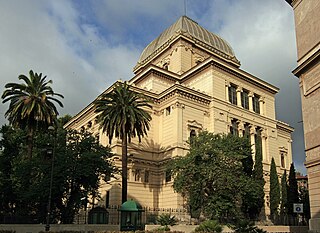
Sant'Angelo is the 11th rione of Rome, Italy, located in Municipio I. Often written as rione XI - Sant'Angelo, it has a coat of arms with an angel on a red background, holding a palm branch in its left hand. In another version, the angel holds a sword in its right hand and a scale in its left.

The Via Giulia is a street of historical and architectural importance in Rome, Italy, which runs along the left (east) bank of the Tiber from Piazza San Vincenzo Pallotti, near Ponte Sisto, to Piazza dell'Oro. It is about 1 kilometre long and connects the Regola and Ponte Rioni.
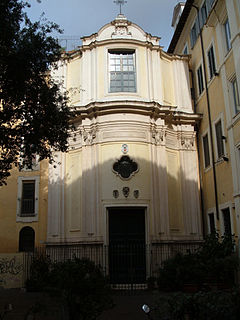
Santa Maria della Quercia is a Roman Catholic church located on the piazza of the same name, one block southeast of the Palazzo Farnese in the Rione (district) of Regola of central Rome, Italy.

San Giovanni Calibita is a Roman Catholic church located in the rione of Ripa on the Isola Tiberina, next to the Fatebenefratelli Hospital.

San Gregorio della Divina Pietà is a small Roman Catholic church facing the Piazza Gerusalemme located in Rione Sant'Angelo, in Rome, Italy. It is located near the Great Synagogue of Rome and the former Jewish quarter of Rome. It is sometimes referred to as San Gregorietto due to its small size. In the past, it was also called San Gregorio a Ponte Quattro Capi or Pons Judaeorum due to its proximity to the bridge known now as Pons Fabricius, connecting the sector to the Tiber island.

The Chiesa di Santa Rita da Cascia in Campitelli is a deconsecrated church in Rome (Italy), in the rione Sant'Angelo; it is located in Via Montanara, at the crossroad with Via del Teatro Marcello. The church formerly rose on the preexisting church of San Biagio de Mercato, dating at least to the 11th-century. The remains of St Blaise putatively were discovered during the dismantling of Santa Rita.

Santa Maria Annunziata in Borgo, popularly known as Nunziatina, is an oratory of Rome (Italy), in the rione Borgo, facing on Lungotevere Vaticano.
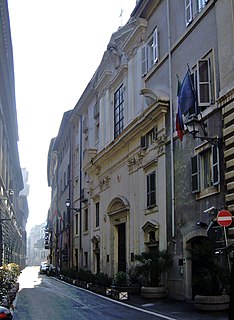
Santissimo Sudario all'Argentina or Santissimo Sudario dei Piemontesi is a church in Rome, sited on the via del Sudario in the Sant'Eustachio district. It is the subsidiary church of the military orders in Italy. It was also once the national church of the Kingdom of Sardinia and is now the regional church for Piedmont and Sardinia. It houses a replica of the Turin Shroud.

Santa Rita da Cascia alle Vergini is a Roman Catholic church in Rome, sited at the corner of Via delle Vergini and Via dell’Umiltà. Diagonal from the church on Via delle Vergini is the Teatro Quirino.

Santa Caterina da Siena is a church in Rome dedicated to Catherine of Siena. It is sited on via Giulia in the Regola district.

Santa Maria della Concezione is a church in Rome, located on Piazza Campo Marzio in the Campo Marzio rione.

San Biagio della Pagnotta or San Biagio degli Armeni is a church in Rome, in the Ponte district, on via Giulia, near Palazzo Sacchetti. It is dedicated to Saint Blaise and is the national church of the Armenian community in Rome.

Via dei Coronari is a street in the historic center of Rome. The road, flanked by buildings mostly erected in the 15th and the 16th century, belongs entirely to the rione Ponte and is one of the most picturesque roads of the old city, having maintained the character of an Italian Renaissance street.
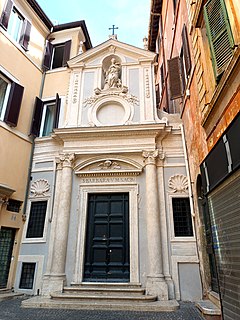
Santa Barbara dei Librai is a small Roman Catholic church in Rome, Italy. It was once known as Santa Barbara alla Regola after the rione in which it was located. Today it now considered within the rione of Parione, near the Campo de' Fiori.

Lungotevere Tor di Nona is the stretch of Lungotevere that connects Piazza di Ponte Sant'Angelo to Piazza di Ponte Umberto I in Rome, in the rione Ponte. It was named so following the resolution of the city council of 20 July 1887.

Santa Maria in Monterone is a Roman Catholic church in Rome, Italy. Its suffix originates from the Sienese Monteroni family, whose patronage rebuilt the church and built a small hospice next to it for pilgrims from Siena. It is located on Via Santa Maria in Monterone in the Sant'Eustachio rione. Next to the church is a Redemptorist monastery, whose clergy manage the church.

Santa Maria della Purità was a church in Rome, important for historical and artistic reasons. Consecrated between 1530 and 1538, the building was demolished together with the surrounding district in 1937-40 during the works for the opening of via della Conciliazione.

San Filippo Neri is a deconsecrated church in Rome, important for historical and artistic reasons. The church, facing the Via Giulia, was built during the Baroque age. San Filippo was supposed to be demolished together with the surrounding neighborhood in the late 1930s, but due to the onset of WWII the demolition was halted. Abandoned and desecrated after the war, it has been restored in 2000, but maintains a secular usage and is not accessible.
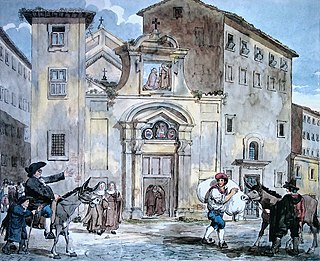
Sant'Urbano a Campo Carleo was a church in Rome (Italy), in the Rione Monti, on the former Via Alessandrina.